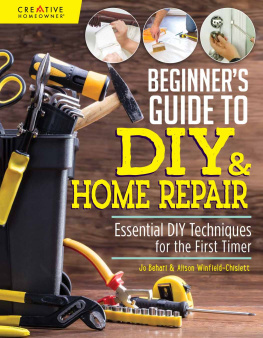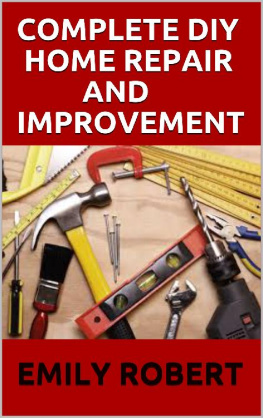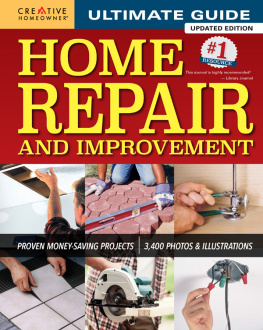Contents
Guide

Safety
Though all the designs and methods in this book have been reviewed for safety, it is not possible to overstate the importance of using the safest construction methods you can. What follows are reminderssome dos and donts of work safety. They are not substitutes for your own common sense.
Always use caution, care, and good judgment when following the procedures described in this book.
Always be sure that the electrical setup is safe, that no circuit is overloaded, and that all power tools and outlets are properly grounded. Do not use power tools in wet locations.
Always read container labels on paints, solvents, and other products; provide ventilation; and observe all other warnings.
Always read the manufacturers instructions for using a tool, especially the warnings.
Use hold-downs and push sticks whenever possible when working on a table saw. Avoid working short pieces if you can.
Always remove the key from any drill chuck (portable or press) before starting the drill.
Always pay deliberate attention to how a tool works so that you can avoid being injured.
Always know the limitations of your tools. Do not try to force them to do what they were not designed to do.
Always make sure that any adjustment is locked before proceeding. For example, always check the rip fence on a table saw or the bevel adjustment on a portable saw before starting to work.
Always clamp small pieces to a bench or other work surface when using a power tool on them.
Always wear the appropriate rubber or work gloves when handling chemicals, moving or stacking lumber, or doing heavy construction.
Always wear a disposable face mask when you create dust by sawing or sanding. Use a special filtering respirator when working with toxic substances and solvents.
Always wear eye protection, especially when using power tools or striking metal on metal or concrete; a chip can fly off, for example, when chiseling concrete.
Never work while wearing loose clothing, hanging hair, open cuffs, or jewelry.


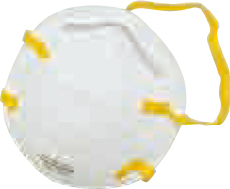
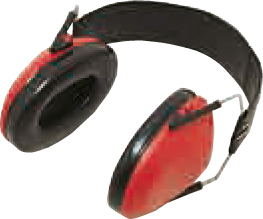
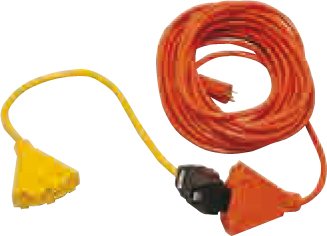
Always be aware that there is seldom enough time for your bodys reflexes to save you from injury from a power tool in a dangerous situation; everything happens too fast. Be alert!
Always keep your hands away from the business ends of blades, cutters, and bits.
Always hold a circular saw firmly, usually with both hands so that you know where they are.
Always use a drill with an auxiliary handle to control the torque when large-size bits are used.
Always check your local building codes when planning new construction. The codes are intended to protect public safety and should be observed to the letter.
Never work with power tools when you are tired or under the influence of alcohol or drugs.
Never cut tiny pieces of wood or pipe using a power saw. Always cut small pieces off larger pieces.
Never change a saw blade or a drill or router bit unless the power cord is unplugged. Do not depend on the switch being off; you might accidentally hit it.
Never work in insufficient lighting.
Never work with dull tools. Have them sharpened, or learn how to sharpen them yourself.
Never use a power tool on a workpiecelarge or smallthat is not firmly supported.
Never saw a workpiece that spans a large distance between sawhorses without close support on each side of the cut; the piece can bend, closing on and jamming the blade, causing saw kickback.
Never support a workpiece from underneath with your leg or other part of your body when sawing.
Never carry sharp or pointed tools, such as utility knives, awls, or chisels, in your pocket. If you want to carry such tools, use a special-purpose tool belt with leather pockets and holders.
Table of Contents


To find over 300 how-to projects, turn the page.
Table of Projects
MONEY-SAVING PROJECTS ARE IN BLUE.
ENVIRONMENTALLY FRIENDLY PROJECTS ARE LISTED IN GREEN.
Replacing a Gas-Fired
About this Book
Think of the Ultimate Guide: Home Repair and Improvement as an owners manual for your housea comprehensive guide that you can turn to any time to help you with day-to-day home repair and maintenance. It is also a valuable source for information on larger, more involved home improvements, such as kitchen and bathroom upgrades.
Inside, youll find 600 pages of helpful information that covers your house from top to bottom, inside and out. Weve laid out the full spectrum of home repair and improvement in 23 chapters that cover tools and materials, home remodeling, outdoor living areas, and every part of the building, including the foundation, the framing, the mechanical systemsthe works.
Home improvement is a big subject, and experienced do-it-yourselfers know it can sometimes be complicated. Ultimate Guide: Home Repair and Improvement helps seasoned homeowners make sense of the subject and further their skills, but you dont need to be an accomplished do-it-yourselfer to use it. Youll find the information you need in sensible text that takes the time to cover the basics. It also offers money- and time-saving tips, explains your options, and shows you what to do using more than 3,300 photographs and illustrations.
There are 325 step-by-step projects that run the gamut from simple repairs, such as fixing a stuck window, to major improvements, such as installing replacement windows. In addition, youll find help with plumbing, heating, cooling, and electrical systems with how-to photo sequences that focus in on the information you need. This latest edition includes updated information on energy-efficient products and building techniques as well as updates on plumbing and electrical work.
Ultimate Guide: Home Repair and Improvement conveys all of this information in a number of informative and entertaining waysmany of which are shown belowincluding step-by-step projects, detailed drawings, and informative photographs.
Throughout the book you will find Green Solutions, which are tips and projects to help you make earth-friendly choices when selecting products and using techniques to improve your home. Money Savers alert you to the opportunity to make a repair or improvement that will save you money in the long runeven if a pro does the work for you. For example, repairing a few damaged roofing shingles to stop a leak is a lot cheaper, and quicker, than a total reroofing project. You will find both highlighted in either green type for Green Solutions or blue type for Money Savers in the Table of Projects, and at the beginning of each chapter.


